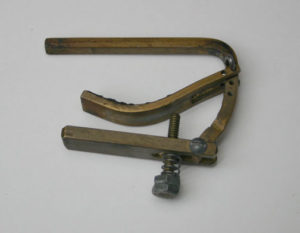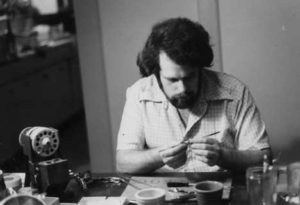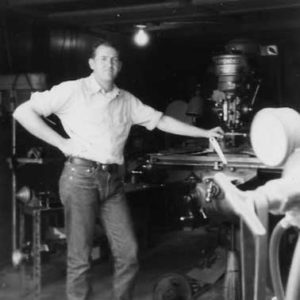A Brief History of the Shubb Company

As told by Rick Shubb
The Shubb Capo company began in California in 1974, when Dave Coontz and I collaborated to design and produce our fifth string capo for banjo. Before that, I worked as a professional 5-string banjo player and teacher, and Dave was an auto mechanic and a banjo student of mine. One night at his lesson, I was talking about my dissatisfaction with existing methods of capoing the fifth string. I described an idea that I had for a fifth string capo that operated on a lever principle, so that it would provide sufficient pressure for a good tone, and ranted about how I couldn’t get anyone in the music products trade interested in making one. Finally, he said “if nobody else will make you one, I will.”
The following week he came to his lesson with a fifth string capo true to my description and drawings. It was roughly hewn out of aluminum, and didn’t look like much …but it worked well. I used it on a gig that week, and had some ideas for improvements.

Me in Portland assembling 5th string capos, circa 1975
For the next few months I would go to Dave’s auto shop in Concord two or three nights a week. I’d arrive at 7 PM (closing time), we’d eat at the local Denny’s, then work until midnight making improvements on our fifth string capo. I’d test-drive it at gigs, and return with more ideas for improvements.
Eventually I was satisfied with it. It did the job for me onstage, and that was all I had set out to accomplish. But requests from other players prompted us to make a few more. Our course was charted the day we bought a small, second-hand milling machine and set about making a hundred units.
I spent the summer of ’74 in the South, making the festival circuit and showing and selling our new fifth string capo. It was very well received, but I returned home with most of those hundred still in a shoe box. For the first few years the capo business was a hobby for both Dave and myself, and didn’t really show signs of becoming much more than that.
Around 1975 Dave moved from California to Iowa in search of elbow room. About that same time, I moved to Oregon in search of something or other. For the sake of continuity, we kept the address for the capo sales the same; that of my mother’s house in Oakland.

Dave and his Bridgeport milling machine, circa 1976
So for awhile, Dave machined fifth string capo parts and farmed in Iowa, I assembled fifth string capos and played in a bluegrass band in Portland, and good ol’ Mom stayed home and shipped fifth string capos from Oakland.
In 1976 I made a trip back to Iowa with the intention of designing a new guitar capo. We tried a few things, but weren’t really getting anywhere. I suggested to Dave that we should tackle another project: a compensated banjo bridge. At that time, banjos all had straight bridges which produced intonation problems on the lower strings in the higher positions. We quickly arrived at the proper scale length for each string — the principle was already well known on other instruments — and then spent nearly three months experimenting with materials, shapes, and measurements to provide the best tone.
Now having two products on the market increased our sense of commitment to being in business, and we resumed our efforts toward designing a new type of guitar capo. Still working in our spare time, the new capo evolved slowly. Some of our early prototypes were not too bad, others might have made a better mousetrap than a capo. But then one day, practically out of nowhere, we nailed it.
By this time I was living in California again, and putting together a new band which was to feature mostly my own tunes. It would have been a good band. But the moment I snapped our newest prototype capo onto a guitar neck, my fate was sealed. The band was pushed into the background, where it faded and dissolved, and my energy was focused on developing and marketing this new capo.
The world, as they say, beat a path to our door. Dave’s farming, like my band, moved to the back burner as we tooled up to meet the demand for the new Shubb capo. He created a full scale, dedicated machine shop, becoming an expert machinist in the process. Music for me, while no less of a passion, was no longer a profession as I now had to learn to be a business man. Whether I ever made this transition is open to debate.
Since that time our dedication to the music products business has never faltered. For a few years Dave maintained a herd of about a hundred Angus cattle, and I’ve been able to keep my touch on the old five string and even play a gig or two now and then, but we both know what puts the bread on our tables: a thirty-four year (and counting) partnership based on a handshake, and a chemistry that starts the creative sparks flying whenever we get together.
We’ve added other products along the way: a banjo pickup and an amplifier, both now discontinued; a line of guitar steels inspired by our good friend John Pearse, and a line of computer software for musicians. Somewhat to my own surprise, I found that I had become an expert at database development, first for my own business, and then for other companies. I took a couple of ideas which I had been using for my own purposes, and polished them up into two packaged software products for musicians: GigMaster and SongMaster. These two products expanded our company into an unexpected direction, but like our capos, they were practical solutions to the real-world problems of musicians. Recently I finally discontinued the software products, as new operating systems did not support the file format used to make them. They were great tools in their time, but that time came to an end.
In 2000 Dave moved from Iowa to Missouri, expanding our production facility in the process. Today the Shubb Company’s three facilities total about 20,000 square feet, and employ about twenty-nine people full time. We exhibit at most of the major trade shows, which we always look forward to, since some of our best friends are in the music business. It is a business and a life which we enjoy very much.
One of our favorite activities remains product development; both the continuing refinement of our existing products, and the creation of new ones. We don’t come up with new products as fast or as often as some companies, but that’s our style. We like to be sure that we’ve got something solid, and that we know the right way to make it. This approach is exemplified by our Shubb Deluxe capo: variation on our original design, we feel that it really elevated the capo to a new level. In 2000 we introduced the Shubb Transposing Guide (and capo placement guide); a simple but handy slide chart to use for changing keys. In January of 2001 we came out with a new type of guitar slide called the “Axys.” It permits the player to alternate between slide playing and regular fretting — instantly. And at the 2002 summer show we introduced our new string winder, which offers mechanical and aesthetic advanages over others.
Anaheim 2003 saw the introduction of the GS guitar steel, a very innovative product developed by Gary Swallows and refined and produced by us.
A new Shubb partial capo was introduced in 2004, along with a revision to the design of our Dobro capo, and a major version upgrade for GigMaster, our software product, still going strong after eight years. Mid 2004 saw upgraded packaging for almost all of our products.
In January of 2005 we introduced Capo Noir; our original capo design in black chrome finish, which is proving to be very popular. A big year for us product-wise, we also introduced the Talon guitar stand, and the Robert Randolph guitar steel.
2008: Our assembly facility in California moved a few miles from Valley Ford to Rohnert Park, giving us more space and a chance to reorganize some procedures. The Valley Ford location remains in service as warehouse space and creative/administrative office. Also in ’08 we introduced an antique finished version of our capos, and the new Shubb Lite …half the weight of our original capo.
In 2011 we introduced our capo for ukulele, and in 2012 we spruced up our Lite capo line by making them available in several vivid new colors.
2013 saw one of the biggest product changes ever for us, as we applied the roller design to our standard line of capos. The roller was previously available only on our deluxe models.
Whatever new directions the Shubb Company might take, you can be sure that one thing will remain unchanged: our absolute dedication to the needs of the musician.

